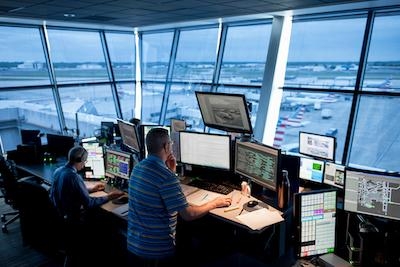Working To Develop The Next Version Of The Air Transportation System
From The Overlook at the Charlotte Douglas International Airport (CLT), a public observation area, enthusiasts can witness planes landing and taking off from the world’s 7th busiest airport — one that handled more than 553,550 departures and arrivals in 2017. That’s a lot of activity for four runways. It’s also a great lab for developing the next generation of Air Traffic Control (ATC), known as NextGen.

For the past few years, American Airlines team members have been working with the FAA and NASA engineers in the airline’s Control Center at CLT to develop the future of not just airspace but also ramp and gate management.
Control Center Lead Agent Kenya Golden has been part of the field testing. She and her fellow team members have shared their professional feedback and experiences to help guide development of tools the industry will use in the future.
“I never thought I’d be working with people from NASA. Absolutely not. But it’s been amazing. Coming from the ramp to the Control Center, I’ve been given this opportunity to see operations from a different perspective and all the different aspects to consider. The NASA engineers have really listened to us, taken our input and created an awesome program.”
Lorne Cass, Vice President of American’s Integrated Operations Center, was the former director of surface operations at the Federal Aviation Administration. Since coming to American he has been positioning the airline to take a leadership role on modernizing surface and airspace operations. Part of this vision is the Airspace Technology Demonstration 2 (ATD-2) program, a five-year project to streamline arrivals and departures and improve ground operations with the purpose of increasing safety and efficiency, and is a key element of the FAA's NextGen vision for surface.
Current systems rely on radar. A transponder on the aircraft detects incoming signals and broadcasts an encoded radio signal with flight information that is used to pass an aircraft from sector to sector. Tracking of a plane on the airport surface has been the black hole of the system, Lorne said. Planes may idle waiting for an open gate or in line to take off.
Slips of paper, flight progress strips, are used on the ground to document status within the Control Center. A tented strip signals to a fellow team member that the plane is delayed at the gate and that team member then has to relay that information to the ramp, the gate agent and the incoming pilot. It’s a tried and true system, but it’s not the most efficient.
“At peak times, we can have 135 planes on the ground — that’s a lot of traffic. It can be a real challenge with the limited ramp space that we have at Charlotte,” said Dec Lee, American’s Vice President of Charlotte Hub Operations.
“The FAA is really good at managing planes in the air and predicting landing schedules,” said Mike Bryant, Managing Director of Control Center Operations in Charlotte. “What we are missing is the same type of overview when planes are on the ground — from the gates to the runways.”
The new system relies on GPS and satellite technology, incorporating real-time data and operational awareness across all systems to allow coordination among the ramp, ATC tower, terminal and Control Center. This information will give air traffic controllers the tools to make better decisions about how to reduce congestion both in the air and on the ground. Everyone working to get a plane from point A to point B will see the same information at the same time. The plane won’t wait for an open gate, because the coordination is done before it lands. Planners can also use that data to more precisely develop schedules, reducing push, taxi and take-off time.
With the new system, it will take planes considerably less time from when they pull away from the gate to get in the air. By holding aircraft at gates instead of idling on the taxiways waiting to take off, planes will burn less fuel. That means omitting less carbon dioxide into the air. Being at the gate also enables crews to connect more passengers and more bags.
Simultaneous advancements are being made on aircraft as well. In May, American announced that it will equip its entire Airbus A321 fleet with ACSS SafeRoute Automatic Dependent Surveillance-Broadcast (ADS-B). ADS-B is a next generation surveillance technology incorporating both air and ground data and providing that information to ATC. That data provides a more accurate picture of an aircraft’s position from gate to gate. ADS-B is foundational part of NextGen that moves ground radar and navigational aids to precise tracking using satellite signals. American’s fleet of Airbus A330s is already equipped with ADS-B technology.
“Our ultimate goal is to improve the flow of aircraft by taking real-time snapshots of how things are working on the ground and better predicting where to put airplanes,” Dec said. “About 80 percent of our passengers here in Charlotte are connecting passengers — meaning timing is of the essence for them to make their next flight. This will give us the tools we need to get those connecting travelers to where they need to be. It will benefit customers and it will benefit our team members.”
(Image provided with American Airlines news release)
 ANN's Daily Aero-Linx (04.15.24)
ANN's Daily Aero-Linx (04.15.24) Classic Aero-TV: 'No Other Options' -- The Israeli Air Force's Danny Shapira
Classic Aero-TV: 'No Other Options' -- The Israeli Air Force's Danny Shapira Aero-News: Quote of the Day (04.15.24)
Aero-News: Quote of the Day (04.15.24) Airborne 04.16.24: RV Update, Affordable Flying Expo, Diamond Lil
Airborne 04.16.24: RV Update, Affordable Flying Expo, Diamond Lil ANN's Daily Aero-Term (04.16.24): Chart Supplement US
ANN's Daily Aero-Term (04.16.24): Chart Supplement US



